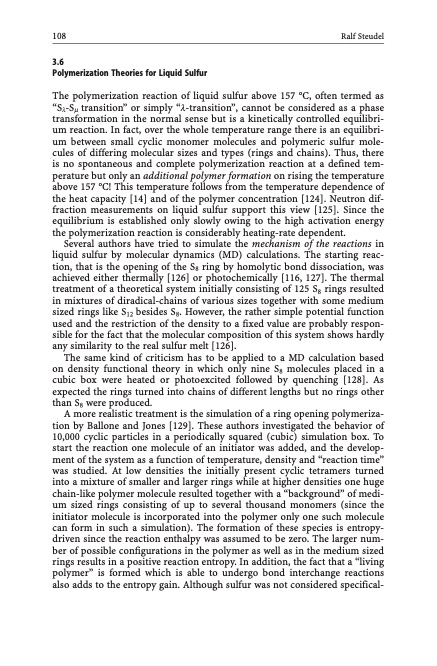
PDF Publication Title:
Text from PDF Page: 118
108 Ralf Steudel 3.6 Polymerization Theories for Liquid Sulfur The polymerization reaction of liquid sulfur above 157 C, often termed as “Sl-Sm transition” or simply “l-transition”, cannot be considered as a phase transformation in the normal sense but is a kinetically controlled equilibri- um reaction. In fact, over the whole temperature range there is an equilibri- um between small cyclic monomer molecules and polymeric sulfur mole- cules of differing molecular sizes and types (rings and chains). Thus, there is no spontaneous and complete polymerization reaction at a defined tem- perature but only an additional polymer formation on rising the temperature above 157 C! This temperature follows from the temperature dependence of the heat capacity [14] and of the polymer concentration [124]. Neutron dif- fraction measurements on liquid sulfur support this view [125]. Since the equilibrium is established only slowly owing to the high activation energy the polymerization reaction is considerably heating-rate dependent. Several authors have tried to simulate the mechanism of the reactions in liquid sulfur by molecular dynamics (MD) calculations. The starting reac- tion, that is the opening of the S8 ring by homolytic bond dissociation, was achieved either thermally [126] or photochemically [116, 127]. The thermal treatment of a theoretical system initially consisting of 125 S8 rings resulted in mixtures of diradical-chains of various sizes together with some medium sized rings like S12 besides S8. However, the rather simple potential function used and the restriction of the density to a fixed value are probably respon- sible for the fact that the molecular composition of this system shows hardly any similarity to the real sulfur melt [126]. The same kind of criticism has to be applied to a MD calculation based on density functional theory in which only nine S8 molecules placed in a cubic box were heated or photoexcited followed by quenching [128]. As expected the rings turned into chains of different lengths but no rings other than S8 were produced. A more realistic treatment is the simulation of a ring opening polymeriza- tion by Ballone and Jones [129]. These authors investigated the behavior of 10,000 cyclic particles in a periodically squared (cubic) simulation box. To start the reaction one molecule of an initiator was added, and the develop- ment of the system as a function of temperature, density and “reaction time” was studied. At low densities the initially present cyclic tetramers turned into a mixture of smaller and larger rings while at higher densities one huge chain-like polymer molecule resulted together with a “background” of medi- um sized rings consisting of up to several thousand monomers (since the initiator molecule is incorporated into the polymer only one such molecule can form in such a simulation). The formation of these species is entropy- driven since the reaction enthalpy was assumed to be zero. The larger num- ber of possible configurations in the polymer as well as in the medium sized rings results in a positive reaction entropy. In addition, the fact that a “living polymer” is formed which is able to undergo bond interchange reactions also adds to the entropy gain. Although sulfur was not considered specifical-PDF Image | Topics in Current Chemistry

PDF Search Title:
Topics in Current ChemistryOriginal File Name Searched:
Elemental-Sulfur-und-Sulfur-Rich-Compounds-I.pdfDIY PDF Search: Google It | Yahoo | Bing
Sulfur Deposition on Carbon Nanofibers using Supercritical CO2 Sulfur Deposition on Carbon Nanofibers using Supercritical CO2. Gamma sulfur also known as mother of pearl sulfur and nacreous sulfur... More Info
CO2 Organic Rankine Cycle Experimenter Platform The supercritical CO2 phase change system is both a heat pump and organic rankine cycle which can be used for those purposes and as a supercritical extractor for advanced subcritical and supercritical extraction technology. Uses include producing nanoparticles, precious metal CO2 extraction, lithium battery recycling, and other applications... More Info
| CONTACT TEL: 608-238-6001 Email: greg@infinityturbine.com | RSS | AMP |